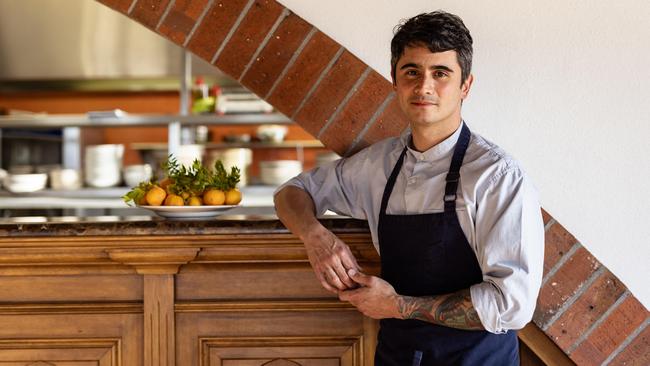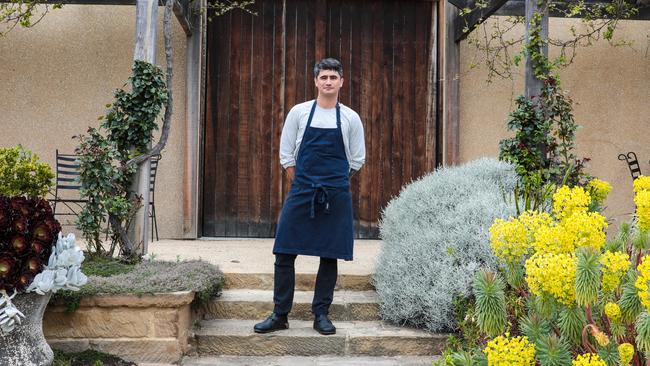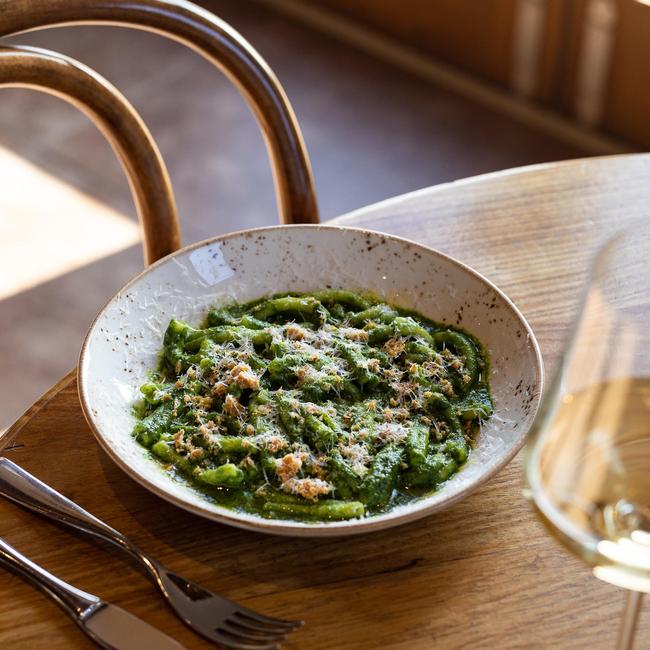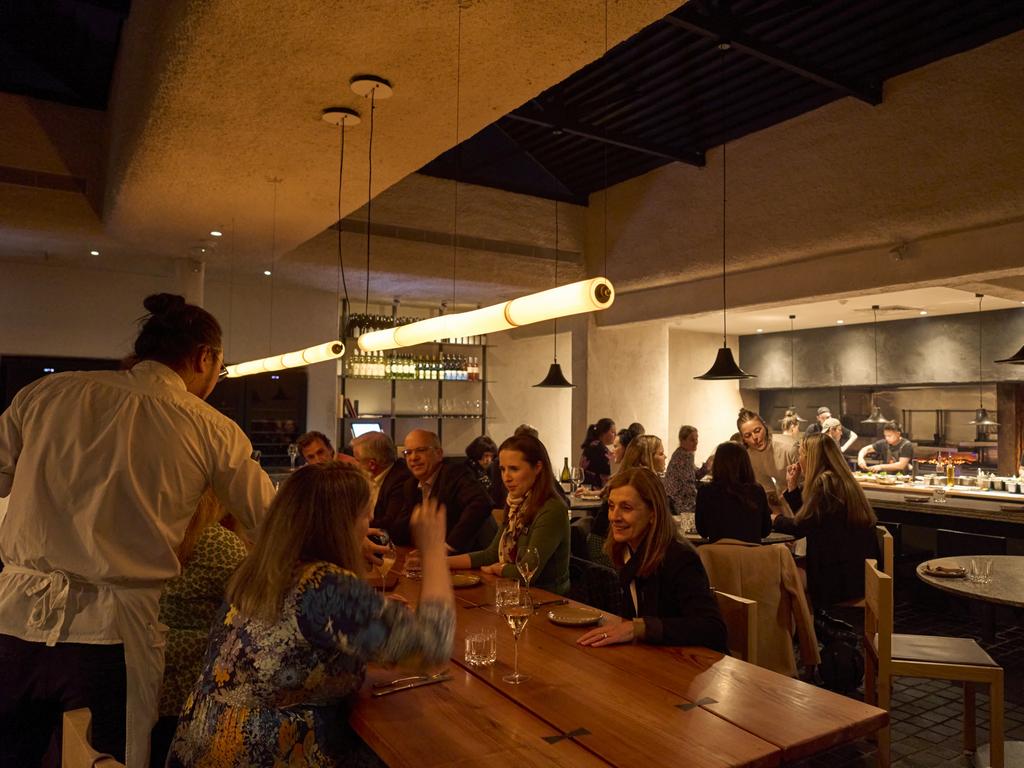Casarecce, spigarello, anchovy, pangrattato from Jeff Workman, head chef, Osteria Vista, Hobart
Jeff Workman is one of Hobart’s up and coming chefs and his food at Osteria Vista, part of Stefano Lubiana Wines estate, is not to be missed.

For generations the traffic across Bass Strait was one way, mostly. These days? No trip to the increasingly cosmopolitan city of Hobart is immune to encounters with Tasmanian-born returnees, mainlanders relocated for the good life and, increasingly, international visitors who want something urban yet remote and close to wilderness.
Chef Jeff Workman fits the middle category, that burgeoning mass from Melbourne and Sydney (rarely Brisbane, too cold) who not only have relocated but also have settled. Properly.
Originally from Sydney, where he apprenticed at Luke Mangan’s Glass Brasserie, Workman credits a brief stint working out of the city, in the northwestern suburb of Castle Hill, as the most influential on the way he cooks today.
It was here he toiled for chef Paul Toogood, at Cibo e Vino, and it was here Toogood’s time at River Cafe in London manifested itself for the fortunate diners. The willing learners in his kitchen, too.
It was another savvy chef, Hugh Whitehouse – who moved from Sydney to Tasmania many years ago to launch the luxe east coast resort Saffire – who lured Workman across Bass Strait.
“Hugh has also been an important influence on my career,” Workman says. “He has this kind of Maggie Beer sensibility to his cooking, straight-from-the-garden comfort food.”
Ten years later, having stayed within the same group of hotels as Saffire to head up Hobart’s Peacock & Jones for five years, Workman is a convert who says there is no way he’s going north again to live. He has become a Tasmanian.
Heaven knows a lot of mainland chefs have gone south and made a big deal about Tassie before heading north again.
And why would Workman want to leave the job he took last year to relaunch the osteria at Stefano Lubiana Wines, just out of town in the Coal River Valley wine region? The hours are ideal for a chap with a young family, he knows where to get the produce he needs, the restaurant does a set menu, which takes a lot of the worry out of things for the kitchen, and the sort of food he loved cooking back at Cibo is exactly what the brief asked for.
Osteria Vista is run by Lubiana’s daughter Isabella and her husband Joel Edwards as part of their Local Hospitality business, a group of Italy-focused venues around Hobart. She plucked Workman from the city and said “simple, honest Italian” (which may be an oxymoron) and Workman is doing the job very nicely.
A set menu lunch here earlier in the year only added to the already impressive food and wine story the city is building.
Workman’s food is excellent, and pasta lovers will recognise true talent.
“The approach is to cook uncomplicated and delicious food simply and seasonally,” says Workman, “with a nod to Italian cuisine that provides comfort while still offering a touch of sophistication.” We think he has nailed it.

The backstory
“This dish is significant to me because it reflects what the food at Osteria Vista is about,” says Workman. “It’s minimal in appearance, seasonal and well-balanced in flavour and seasoning. (But) the method behind it takes care and intuition to make the sauce.”
Indeed, for me, as a pasta fan, this dish was the highlight of an excellent lunch at Osteria Vista. The house-made extruded casarecce made a big difference but, as Workman says, if you’re not going to make the pasta yourself – and casarecce isn’t Pasta 101 – buy the very best you can afford.
“The shape is a perfect vessel for the sauce,” he says.
The spigarello sauce is made every morning in season and according to reservations in the dining room. Spigarello is an heirloom Italian green belonging to the Brassicaceae or broccoli family. There are many different varieties of spigarello found in both smooth and curly forms, and the leafy green is considered to be the ancient parent of broccoli rabe.
Given it’s a rare vegetable, Workman says fresh spinach is a perfectly good substitute, and its availability is far greater.
“This dish is also significant to me and the restaurant because it’s the first one I collaborated on with my sous chef Ishan Acharya – another Sydneysider in Hobart – and it’s been a huge success.
“Autumn is my favourite time of year in Tasmania and that’s when the spigarello is typically available.”
The produce
There’s not a whole lot to this dish, so it’s important the individual components are of the best quality you can find.
“Our spigarello is supplied weekly by a farm of young and enthusiastic organic growers, Tony Scherer and Joyce Johnston, at Rocky Top Farm in Penna near Richmond.”
One senses among Hobart’s better chefs a real commitment between kitchen and grower that’s probably a little easier when the city is as small as this.
It’s a similar story for Massimo Mele at The Tasman’s Peppina. The chefs work hard to cultivate the relationships.
“The spigarello has such a full-bodied, rounded flavour that it can really handle big flavours, such as anchovy, to enhance it.”
Workman says finding organic produce will make a big difference, particularly with something such as garlic. He recommends Rustichella d’Abruzzo as an off-the-shelf brand of dried pasta; we recommend spending the extra on really good anchovies, such as Olasagasti, from Cantabria, Spain.
The method
Essentially, this is simply a matter of making a pangrattato crumb to garnish the dish, making the sauce, cooking the pasta, putting them together and plating. But there are important tips.
“The blanching of the spigarello is really important,” Workman says, “because it needs to be cooked enough to blend smoothly, but not so long as to lose the vibrancy of the colour. It’s really important to put the cooked vegetable straight into an ice bath.”
Another notable twist to this method is that the anchovies are not cooked into the dish; they are added, along with the pecorino cheese, to complete the sauce almost like a seasoning.
And, as with so much Italian cooking, it is a matter of tailoring the final product to your palate; the recipe is a guideline, not the Bible, the chef says. “Carefully add more pecorino, anchovy and lemon juice to get the balance that works for you.”
The twist
“To me the dish is unassuming, it is minimal in appearance but has bold flavours,” Workman says.
“The seasoning of the sauce needs to be adjusted with every pasta that is sent out and is a balancing act of layers until you get the flavour to the right point where it all counteracts one another and is pleasing on the palate. The sauce consistency also needs to be right for the casarecce to hold the sauce and for the sauce to keep its vibrancy.”
The price
At Osteria Vista they charge $85 for a set menu that includes antipasti (five to six dishes), a pasta course, protein with sides and garnishes, and a dessert. Wine pairing can be added for an additional $49. It’s outstanding value for money.

Spigarello casarecce with pangrattato
Serves: 4
INGREDIENTS
Pangrattato
● Half loaf of day-old bread (we use our focaccia)
● 1 lemon zest – keep juice to finish the sauce
● 1 organic garlic clove
● Half bunch flat leaf parsley
● 400ml extra virgin olive oil
Spigarello sauce
● 200ml olive oil
● 4 shallots, sliced
● 3 garlic cloves, sliced
● 200ml vegetable stock
● 200ml dry white wine
● 1 large bunch of spigarello
or 400g fresh spinach
● 320g casarecce pasta
● 400g pecorino
● 20g high-quality anchovy
● 80g unsalted butter
METHOD
For pangrattato
Set oven to 150C.
Trim any crust from the bread, pulse in a blender or tear.
Mix oil and bread to coat evenly, then put in a baking tray and cook until golden brown, 8-10 minutes. Fold in sides of tray periodically for even colour.
Zest lemon and garlic with a Microplane and chop parsley. Mix.
Once the crumb has cooled, add parsley mix and rub it into the crumb.
For spigarello sauce
Heat a medium-sized pot on low heat, add half olive oil and sweat shallots and garlic until translucent.
Add white wine and vegetable stock and reduce by half, allow to cool.
Bring medium pot of water to boil and season with salt. Have a bowl of iced water ready.
Roughly chop the spigarello and blanch until tender, 1 to 2 minutes. Strain and immediately chill in iced water. Squeeze excess water from spigarello once chilled.
Blend half the reduced liquid with spigarello on high until completely blended, then add the rest of the stock.
Blending at medium, slowly add the rest of the extra virgin olive oil.
Finish the sauce by blending the anchovies and 200g of grated pecorino.
Check for seasoning.
Pass the sauce through a fine sieve and cool.
Cook the pasta in salted water and warm the sauce in another pan; add the pasta to the sauce and then add the butter.
Emulsify the sauce by tossing everything in pan.
Finish with a squeeze of lemon juice and divide into four heated bowls.
Finish with pangrattato, the balance of the finely grated pecorino and extra virgin olive oil.



To join the conversation, please log in. Don't have an account? Register
Join the conversation, you are commenting as Logout